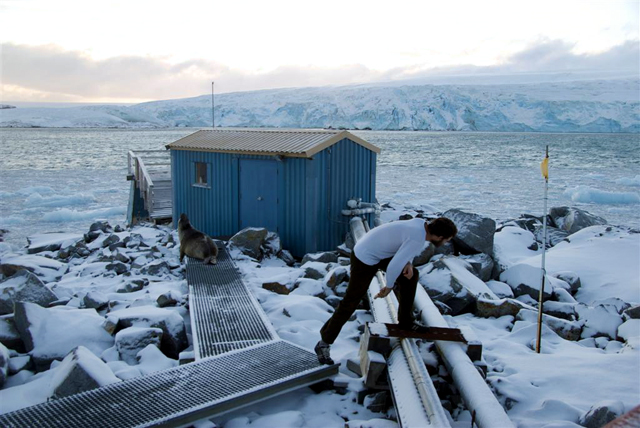Page 2/2 - Posted July 24, 2009
Getting aroundIn fact, the self-described nerd now calls himself an “action nerd” on his blog “Compared to most of the jobs here, I definitely go to one of the bigger areas,” he said. “I’m either hiking up the glacier, hiking through the backyard [behind Palmer Station], or taking a boat out to one of the peninsulas.” The Last Word
Research associates talk about what they love best about their jobs: The last word
Fuhrmann also doesn’t spend too much time behind a computer unless it’s to communicate with one of the National Science Foundation (NSF) It’s a trip he has to make every day no matter the holiday or weather outside. “It’ll be minus 70 [degrees Fahrenheit], dark as all heck, blowing 30-plus knots with one to two meters visibility, and you’re feeling worn out (the South Pole does that considering the high-altitude and lack of humidity, which is often accompanied with lack of sleep), but the walk to ARO that I’ve been putting off most of the day must still take place.” Getting trainedDespite strong backgrounds in science and engineering, the RAs have a diverse set of instruments to maintain. Each spends several weeks traveling around the United States to various institutions for training. “Most of the training I received revolved around becoming familiar with the instrumentation and associated software,” Bryenton said. “It also gave the researchers and me a chance to meet and become familiar.” Said Fuhrmann, “After the trips, I would stress the priority was more of them meeting the stranger that will be taking care of their project for a year.” Bryenton traveled to five different facilities in the course of about a month, crisscrossing the country, from Alaska to both coasts. “It was mentally and physically exhausting,” he said. Long daysThe long, dark winter months are no less challenging for the research associates. At the smaller Pole and Palmer stations, the research associates, like all their fellow winter-overs, not only have their regular jobs to do. For instance, Scheibe and Fuhrmann serve on emergency response teams and each grabs a broom when it’s his turn for general station housekeeping, known as “house mouse” on the Ice. Then there’s the dozen projects that Scheibe oversees, not including his meteorological duties and all the associated paperwork and reports. “When you put it all together, it makes a pretty full week,” Scheibe said. And that all assumes that each gizmo is in good working order — an unlikely scenario given the harsh Antarctic conditions, particularly over the winter. Temperatures at South Pole can drop below minus 100 degrees Fahrenheit. McMurdo can also experience extreme drops in temperature, as well as storms that pack hurricane-strength winds. Palmer is also known for its stormy weather, with the Antarctic Peninsula one of the cloudiest places on the continent. “There are occasions when a project develops a problem, and that is the real reason I’m here,” Bryenton said. “I’ve been trained to trouble shoot the instruments, and work with the available resources to bring the systems back up as soon as possible. I’ve had to put in some long days fixing problematic instruments.” Other duties as assignedNot everything in the course of the RA’s day is in the original job description. Fuhrmann finds plenty else around the station that requires repair, pitching in when he has time. There’s such life-sustaining equipment as the Cappuccino maker — no winter-over should be without strong cupfuls of coffee — and a temperamental sewing machine in the station craft room that he’s working on. Other projects are more Thomas Edison-esque, including construction of a multi-fan system in the station growth chamber, a hydroponic greenhouse, to grow Romaine lettuce, as well as a prototype water-flow sensor for the plant trays. He’s even developed several versions of heated goggles to prevent fogging and icing outdoors with mixed results. “If you were to take a look at the messy lab bench in front of my desk, you would have to guess that tinkering is also a hobby,” Fuhrmann said. Scheibe has fallen into a sort of outreach role, fielding questions through his blog, and more recently doing interviews with stateside media, including a conversation with Oprah Winfrey on a special episode featuring Skype calls around the world. “It was quite unexpected,” he said. “I got called into the station manager’s office, and I thought I was in trouble, but I didn’t really know how much trouble I was in until they told me that I was going to be on national TV representing the whole USAP basically. “That is not part of the normal RA duties for sure,” he added. “Sometimes you dig a hole, sometimes you talk to a billionaire on national television.”Back 1 2 |
"News about the USAP, the Ice, and the People"



For USAP Participants |
For The Public |
For Researchers and EducatorsContact UsNational Science FoundationOffice of Polar Programs Geosciences Directorate 2415 Eisenhower Avenue, Suite W7100 Alexandria, VA 22314 Sign up for the NSF Office of Polar Programs newsletter and events. Feedback Form |



